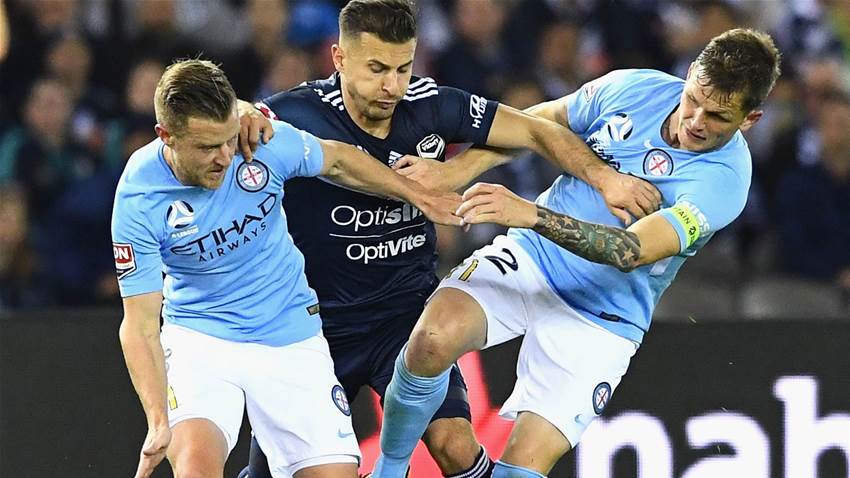The first Melbourne Derby of the 2017/18 season ended in delight for Melbourne City, who posed problems for Victory throughout the match which largely went unanswered.
Warren Joyce seems to be an intelligent pick-up for City so far, with maximum points being taken from the first two matches, as well as an early implementation of a form of positional play.
Muscat’s problem: building up through the middle
Melbourne Victory are not a team short on talent by any stretch of the imagination. Many would argue that they have the best squad in the league on paper, with Socceroos James Troisi and Mark Milligan coming straight back into the starting line-up after having missed last weekend’s Big Blue due to national team duty.
Building up through central areas has been an important part of Victory’s strategy in possession for the last few seasons, who generally look to take advantage of the qualitative superiority that they usually enjoy. However, Joyce combated this by taking a defensive approach which has not been commonly seen in the A-League in the past, giving Stefan Mauk clear instructions to block the passing line to Mark Milligan as frequently as possible.

As pictured above, Mauk restricts the ability of the Victory centre-backs to introduce Milligan during build-up, which has flow-on effects to the rest of the defensive system.
First, Ross McCormack is responsible for applying pressure on the ball carrier, with the closest winger acting as the second defender and closing down the relevant full-back. The opposite winger shifts medially to sit next to the free centre-back in order to remove the viability of a passing option.
In behind Mauk, the passing line of the ball-side midfielder is cut by one of the City holding midfielders, with the other man-marking the remaining Victory player on the inside of the pitch. The closest winger is marked by the respective full-back, with the only Victory players in space being the opposite winger and to a lesser extent the opposite full-back. As a direct result of this, Muscat’s options were reduced to a few possibilities:
- Be forced to play into wide areas where Melbourne City possess numerical superiority from a defensive stand point; or,
- Be forced to play long, direct balls to Besart Berisha or ask the wingers to enter into aerial battles; or,
- Be forced to pass into central areas where the remaining two midfielders receive the ball under pressure, leading to a higher frequency of turnovers than is usually to be expected.
Overall, any of these outcomes reduce the rate of penetration via central areas significantly. Clearly, it would be in Melbourne Victory’s best interests to find a solution to this problem. So how did Kevin Muscat respond?
Victory’s inconsistent response
Late in the second half, Victory seemed to have come across an answer to the question of how to remove the obstructions to being able to build up through the middle. When his team were in possession, Milligan dropped all the way between the two centre-backs, in turn allowing the full-backs to push higher up the field, which created space in the middle of the pitch as a result.
A tactic similar to this has been employed by top-flight teams in the past, such as Bayern Munich under Pep Guardiola and more recently Mauricio Pochettino’s Tottenham side. The ‘extra’ central defender provides the necessary cover to allow the full-backs to have more confidence to progress up the pitch, whilst at the same time maintaining their width.

City’s take on positional play
Positional play is a relatively recent advancement in tactical knowledge, and is generally attributed to a development on the idea of Total Football. Popularised by Guardiola’s Barcelona, positional play, or Juego de Posición, is based upon the principle of occupying spaces within a set formation.
This differs to Total Football, which is more related to complete freedom on the pitch and the releasing from a traditional system to allow for more creative expression. In this sense, former Manchester United reserves coach Joyce employed a tactical approach which contained elements of positional play, which directly contributed to their good performance.

This was particularly evident in two key areas, with the first being during build-up from the goalkeeper or centre-backs. Remembering that positional play is based on filling specified zones and maintaining balance on the pitch, this defensive-to-middle third rotation occurred as follows:
- One, or both of, the holding midfield pair drops vertically towards the player with the ball. In the example above, it can be seen that the left-sided holding midfielder has dropped in order to offer an option behind the first line of pressure.
- The full-backs react to ensure balance across the pitch and the maintenance of two players on two lateral lines. Above, as the left holding midfielder has dropped, the left full-back must move forward in order to maintain balance. It can be seen that that both pairings of full-backs and midfielders operate diagonally to each other as indicated by the red line. This is important, as it ensures more difficulty for the defensive team who are now spread over multiple lines.
- If the full-backs are providing the width, the wingers move medially to position themselves in the relevant half-space, attacking an area of the pitch which has been identified by many as vulnerable, especially against teams which operate with a back four.
- Stefan Mauk, the central attacking midfielder, moves into a position to receive the ball in an advanced position.
In doing so, City create a variety of different options for the player on the ball, which increases the likelihood of a successful construction of possession, which flows naturally into the creation of chances.
The second key area which espoused elements of positional play was during the chance creation phase of possession, and particularly at the moment of penetration.

Ross McCormack played somewhat of a free role throughout the match in an aim to create numerical superiority in advanced areas of the pitch, but he also played a pivotal part in dictating the movements of those around him in the final third. As in the example of positional play during build-up earlier, all spaces must be filled in a way which provides a continuity of balance to the team, regardless of the individual who fills the position. The latter point is even more relevant in the final third, with each player in the City front four making a different movement depending on the direction of McCormack’s run.
In the example above, McCormack leaves the central area to take up a new position on the left wing. This causes the following reactionary movements to occur as his teammates look to ensure that four vertical channels are filled in order to attack with some degree of variability:
- Bruce Kamau, previously positioned on the left wing, makes a run into the left half-space, as McCormack has already filled his default position.
- Stefan Mauk looks to take advantage of the central space vacated by McCormack and progresses forward.
- Nick Fitzgerald continues his run to attack the space available behind the furthest full-back and in front of the far post.
The above movements are focused on occupying the four highlighted spaces in a way which is conducive to the successful creation of a goal-scoring opportunity. This movement causes defenders to be dragged out of position, causing havoc in the final third and spaces to open up in critical areas. City’s attempt at a version of positional play was successful and ensured an uneasy defensive performance from the usually resolute Melbourne Victory.
Conclusion
Although it is still very early in the season, Melbourne City look to be a completely different team under new boss Joyce, and have picked up maximum points from their first two games.
Kevin Muscat may well regret the inconsistent execution of a potential strategy to get Milligan and his midfield colleagues into space, with issues in possession plaguing his side for virtually the entirety of the game. The implementation of a form of positional play from Melbourne City looks set to pay dividends, with Ross McCormack offering more dynamism than Bruno Fornaroli has done in the past. All in all, a successful Melbourne Derby for City, whilst it was a disappointing night for the Victory.
Nathan Muir is an Australian tactical analyst and coach. You can find him on Facebook @ Nathan Muir Football or on Twitter @NathanKMuir.
Related Articles

Victory's Machach wants to make amends in decider

Leckie seals new marquee deal as Good, Maclaren head to Asia
.jpeg&h=172&w=306&c=1&s=1)












